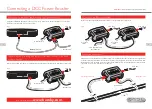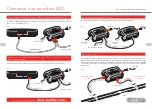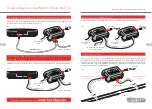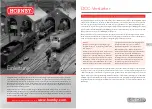
2
DCC Power Booster
On larger layouts where there is a degradation of the DCC signal at extreme distances from the DCC controller
it is usual to divide the track into “Electrical Districts” each being driven from a dedicated Power Booster. DCC
signal degradation on very large or complex layouts can still occur even if a ‘Buss’ wiring technique is used to
supply power to the track.
Each Power Booster is controlled by taking a DCC signal from the Main Controller or from a location on the
track where a good DCC signal is present.
Also, Power Boosters allow more locos to be run on the same layout. Normally, the number of locomotives that
can be run on any layout will be limited by the maximum current available from the power supply feeding the Main
Controller and its associated Booster.
Introduction
For more information visit:
www.
hornby
.com
A Hornby Digital Booster can be fitted to a model railway layout in order to supplement an existing controller
by providing extra track power. The Hornby Digital Booster can also be used to automatically handle track polarity
reversal when connected to a Reverse Loop or Wye track configurations. The Hornby Digital Booster will also
boost the digital signal from either a Hornby Select, Elite or an alternative controller and may also be linked to
another booster.
A Hornby Digital Booster is ideal for large layouts which have in the region of 500 plus feet of track however on
exceptionally large layouts it maybe necessary to divide the layout into separate “power areas”. If in doubt consult
your Hornby Digital stockist or contact the Hornby Helpline.
A DCC Power Booster provides the following functions...
Please Note:
This Main Controller and associated Booster are
integrated in the Select and Elite controllers.
If it is desired to run more locos than the limit
governed by the power system of the Main
Controller/Booster, then it will become necessary to
divide the layout into isolated “Electrical Districts”
each being driven by its own dedicated Power
Booster. This will allow additional locos to be run
in each “Electrical District” up to the maximum
allowed by the power supply used by the “Electrical
District’s” Booster unit.
Creating an “Electrical District” and adding a Power
Booster to drive it does NOT increase the number
of locos capable of being run in any other district.
The part of the layout making up the first “Electrical
District” is connected to the Main Controller/Booster.
This is the “Prime Electrical District”.
Generally the use of Power Boosters is dependent on the architecture of the layout and the maximum number of
locos to be run at any one time. i.e. A relatively small layout may contain many “Electrical Districts” if a large number
of locos may be in operation at any one time.
Then again, if you have a large layout you may need to add “Electrical Districts” and Power Boosters to ensure the
“quality” of the DCC signal at all points of the layout. A complex layout with “fiddle yards” and “long runs” of track
may contain many “Electrical Districts” of different physical sizes or track running lengths.


































